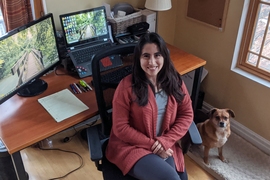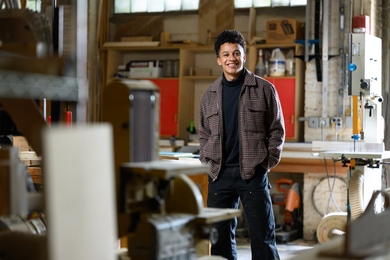When Muni Zhou looks into a clear night sky, she might be focusing less on the stars and more on what cannot be seen with the eye. The MIT graduate student, now in her fourth year at the Plasma Science and Fusion Center (PSFC), is fascinated by vast magnetic field structures that exist not only around planets like Earth, but beyond the heliosphere to the edges of the universe. How these cosmic magnetic fields originated and evolved is the longstanding theoretical puzzle she is helping to solve.
Zhou’s interest in physics developed as a teenager in Shenzhen, China, one of the country’s technology hubs.
“Physics teaches us not only about what happens at the edge of the universe, but about what we observe in our environment every day, including our technology,” she says. “It helps me understand the world around me.”
As an undergraduate student at Zhejiang University she explored several fields of physics, eventually focusing on plasma science, excited by its application to fusion research with its potential for producing a reliable supply of carbon-free energy.
Her fascination with the topic increased while working with the supportive community at the university’s Institute of Fusion Theory and Simulation (IFTS).
A chance to be an exchange student at Princeton Plasma Physics Laboratory (PPPL) provided Zhou with her first serious research opportunity. The project focused on the physics of a tokamak, a fusion device that uses strong magnetic fields to contain and shape plasma while it is heated to extreme temperatures.
The study, and the subsequent undergraduate thesis it generated, prepared her for similar research at MIT in the Department of Nuclear Science and Engineering. With the guidance of her advisor, Professor Nuno Loureiro, her plasma research has taken an astrophysical turn, resulting in an article about cosmic magnetic structures, recently published in the Journal of Plasma Physics. NASA also acknowledged Zhou’s research with a Future Investigators of NASA Earth and Space Science Technology (FINESST) grant, which supports graduate student-designed projects that help to further the Science Mission Directorate’s science, technology, and exploration goals.
Magnetic fields are ubiquitous in the universe. They are dynamically important, participating in the formation of stars and galaxies. Cosmic magnetic fields possess intriguing gigantic-scale coherent structures. Zhou explains that these structures could possibly evolve from miniscule-scale magnetic “seed fields,” which are generated by instabilities in the plasma medium that is part of astrophysical systems throughout the universe.
“In supernova explosions, gamma-ray-burst jets or large-scale accretion shocks at the outskirts of galaxies during early stages of galaxy formation, these magnetic seed fields form at microscopic scales,” says Zhou. “But these tiny fields, through interaction with plasmas, can potentially increase their coherence length by many orders of magnitude to become the enormous astronomical-scale magnetic fields observed in the universe.”
This so called “inverse cascade,” the process by which a magnetic field grows from small to large scale, is crucial in forming cosmic-scale magnetic fields.
Zhou’s research is dependent on conceptualizing this plasma system with its seed fields as a sea of flux ropes — ropelike plasma structures threaded by magnetic field lines.
“Now that we have simplified this complex astrophysical phenomenon to an idealized concept we can investigate,” she says, “the question becomes, what are the dynamics of this large ensemble of magnetic flux ropes? And can their interactions expand a small-scale magnetic field to much larger scales?”
Zhou and her colleagues have found that the growth of a magnetic field’s scale depends on the coalescence of these flux ropes. This is facilitated by the process of magnetic reconnection, in which oppositely-directed magnetic field lines tear and reconnect, releasing magnetic energy. When two flux ropes interact, their field lines reconnect, merging into a larger flux rope and expanding the scale of the magnetic field.
When Zhou tested the phenomenon with supercomputer simulations, she observed that the system rapidly became chaotic when the flux ropes began interacting, developing an unconventional type of turbulence. Nevertheless, she was still able to observe the expansion of magnetic fields. The analytical model suggests that this interaction of flux-ropes can grow the magnetic field to larger scales.
Loureiro, whose National Science Foundation CAREER Award funds this research, is impressed with Zhou and her results, noting that in their discussions she already feels more like a colleague than a student.
“The problem she is working on is very hard, and yet she’s already made more progress on it than I could have reasonably expected,” he says. “I feel like this paper of hers really is a fundamental contribution that will be very impactful.”
Zhou feels the results have a kind of beauty.
“It is very elegant, to me,” she says. “In such a complex turbulent system, the plasmas self-organize. As a result, we see the formation of large-scale magnetic structures. It is a beautiful example of how order can emerge from chaos.”










